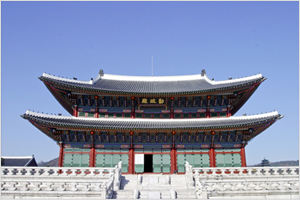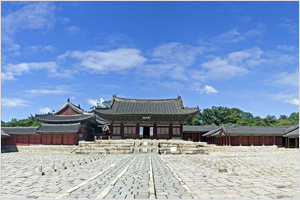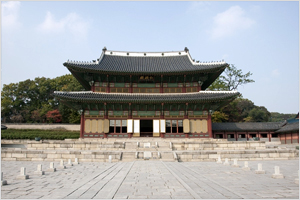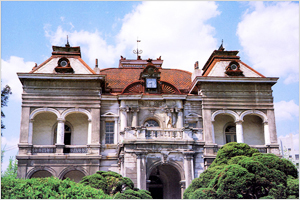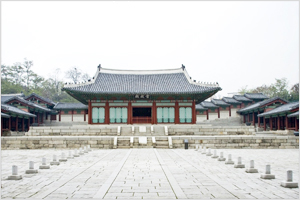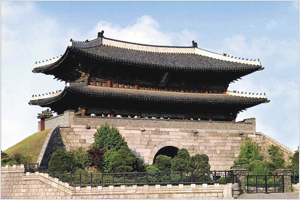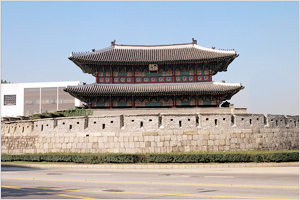About Korea

- About Korea
- Travel Date
Travel Date
Kyongbokgung Palace
- Kyongbokgung Palace was built in 1395 by King T'aejo. "Kyongbok", meaning wish happiness, was named after a phrase of "kyongbok"(meaning "invoke a blessing upon a man of virtue at the twilight of his life) in a poem in Shikyong. Kyongbokgung has several palaces such as Kunjongjon, Sajongjon, Chonchujon, Manchunjon, Kangnyongjon and Kyotaejon. Many cultural assets scatterd throughout the country have been moved to the palace - 7 National Treasures including 10-story stone pagoda of Kyongchonsa Temple(National Treasure No. 86), Memorial Stupa for the Most Reverend Chigwang of Popchonsa TempleNational Treasure No. 101), and 11 Treasures. This palace of Historical Site No. 117.
- Location : Sejongno 1, Chongno-gu, Seoul
- Area : 308,263 m2
- Transfortation : Take Subway Line 3 and Get off at Kyongbokgung Station
- Closing Day : on Tuesdays
- Admission Fee(Won) : 700
- Phone Number : 732-1931
Changgyonggung Palace
- Changgyonggung Palace was built in 1419 by King Sejong for King Taejong. Its original name was Suganggung Palace, but in 1483(the 14th year of the reign of Songjong) three more palaces were built for three gueens(Chonghee-wanghoo, Sohye-wanghoo and Ansu-wanghoo) and renamed as Changgyonggung. This palace was burned down during Imjimwoaeran War and was renovated to its original state in 1616(during the reign of King Kwanghaegun)
- Location : 2-1, Waryong-dong, Chongno-gu, Seoul
- Area : 217,813.4m2
- Transfortation : City Bus Number 1-2, 5, 5-1, 6, 8, 84, 205, 710
- Closing Day : On Tuesdays
- Admission Fee(Won) : 700
- Phone Number : 762-4868
Changdokkung Palace
- Changdokkung Palace was built as a detached palace for a Crown Prince by King Taejong, the 3rd king of Choson Kingdom. But it served as the main palace, where kings lived and ruled over the coutry, for nearly 300 years after King Kwanghaegun. Palaces such as Injongjon, Sonjongjon, Taejojon, Naksonjae remain in Changdokgung. The remained 41 buildings(13 inside Changdokgung and 28 inside Piwon) keep solemnity of royal palaces. Especially, a back garden of the palace called Piwon(Secret Garden) is famous by its many pavillions and ten thousands of trees and flower plants. Piwon is an exellent example of travelImg's traditional naturalistic landscape design and has a 1,000- year-old tree measuring more than an arm's span around and 700-year-old juniper(Natral Monument No. 94)
- Location : 2-71, Waryong-dong, Chongno-gu, Seoul
- Area : 579,584 m2
- Transfortation : Take Subway Line 3, Get off at Anguk Station and walk 5 minutes
- Closing Day : On Mondays
- Admission Fee(Won) : 2,200
Unhyonkung Palace
- Unhyonkung Palace was the residence of Hungsondaegun(1820-1898), the father of King Kojong, the 26th king of Choson Kingdom. King Kojong was born and lived here until 12 just before his enthronement. After Kojong became a king, the palace was a historical site where Hungsondaegun mapped out and practised the reformed politics.
- Unni-dong, Chongno-gu, Seoul
- Area : 9,413.2 m2
- Admission Fee(Won) : 700
- Phone Number : 731-0530
Kyonghuigung Palace
- This Palace was built in 1616(the 8th year of the reign of King Kwanghaegun) with Inkyonggung and Chasugung inside it. Its original name was Kyongdokkung and the name was changed into Kyonghuigung in 1760.
- Location : 1-126, Shinmunno 2, Chongno-gu, Seoul
- Area : 98,470.8 m2
- Transfortation : Take Subway Line 5 to Kyongbokgung Station and walk 5 minutes toward Sodaemun
- Closing Day : No Closing Days
- Admission Fee(Won) : Free
- Phone Number : 739-8971
Toksugung Palace
- Toksugung Palace was originally built as a villa for Prince Wolsandaegun, an elder brother of King Songjong, the 9th king of Choson Dynasty. In 1897 when King Kojong returned here from Russian legation, again it was used as a royal mai palace and renamed as Toksugung Palace, meaning praying the longevity of King Kojong.
Namdaemun
- Namdaemun was the main south gate of the old city wall of Seoul. It was first built in the 7th year of the reign of King Taejo(1398) and renovated in the 30th year of the reign of King Sejong. Its original name was Sungryemun, and it has been also called Namdaemun because ot is located in the south of the city walls. This gate is th oldest wooden structure in Seoul.
Tongdaemun
- Tongdaemun was the main east gate of the city walls of Seoul. Its original name was Hung-injimun. Hung-in means the east. It was first built in the 5th year of the reign of King Taejo(1396), rebuilt in the 1st year of the reign of King Tanjong(1453), and rebuilt again in the 6th year of the reign of King Kojong(1869) in its present form. The gate is surrounded by the outer walls, which are reasonably planned facilities to attack enemy. The granite base is pierced by a single arch, a gateway called Hongyemun. The wooden superstructure is a two-story pavilion, which is 5 kan wide and two kan deep, with a hipped roof. The tongue-shaped arnamentation at the top of the columns and elaborate and ornament-centered detail technics are typical of the archtectures of the Late Choson Period.

